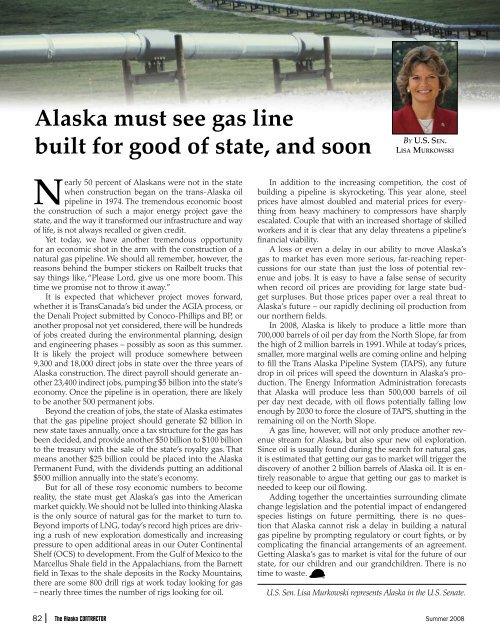The Alaska Contractor - Summer 2008
The Alaska Contractor - Summer 2008
The Alaska Contractor - Summer 2008
You also want an ePaper? Increase the reach of your titles
YUMPU automatically turns print PDFs into web optimized ePapers that Google loves.
<strong>Alaska</strong> must see gas line<br />
built for good of state, and soon<br />
Nearly 50 percent of <strong>Alaska</strong>ns were not in the state<br />
when construction began on the trans-<strong>Alaska</strong> oil<br />
pipeline in 1974. <strong>The</strong> tremendous economic boost<br />
the construction of such a major energy project gave the<br />
state, and the way it transformed our infrastructure and way<br />
of life, is not always recalled or given credit.<br />
Yet today, we have another tremendous opportunity<br />
for an economic shot in the arm with the construction of a<br />
natural gas pipeline. We should all remember, however, the<br />
reasons behind the bumper stickers on Railbelt trucks that<br />
say things like, “Please Lord, give us one more boom. This<br />
time we promise not to throw it away.”<br />
It is expected that whichever project moves forward,<br />
whether it is TransCanada’s bid under the AGIA process, or<br />
the Denali Project submitted by Conoco-Phillips and BP, or<br />
another proposal not yet considered, there will be hundreds<br />
of jobs created during the environmental planning, design<br />
and engineering phases – possibly as soon as this summer.<br />
It is likely the project will produce somewhere between<br />
9,300 and 18,000 direct jobs in state over the three years of<br />
<strong>Alaska</strong> construction. <strong>The</strong> direct payroll should generate another<br />
23,400 indirect jobs, pumping $5 billion into the state’s<br />
economy. Once the pipeline is in operation, there are likely<br />
to be another 500 permanent jobs.<br />
Beyond the creation of jobs, the state of <strong>Alaska</strong> estimates<br />
that the gas pipeline project should generate $2 billion in<br />
new state taxes annually, once a tax structure for the gas has<br />
been decided, and provide another $50 billion to $100 billion<br />
to the treasury with the sale of the state’s royalty gas. That<br />
means another $25 billion could be placed into the <strong>Alaska</strong><br />
Permanent Fund, with the dividends putting an additional<br />
$500 million annually into the state’s economy.<br />
But for all of these rosy economic numbers to become<br />
reality, the state must get <strong>Alaska</strong>’s gas into the American<br />
market quickly. We should not be lulled into thinking <strong>Alaska</strong><br />
is the only source of natural gas for the market to turn to.<br />
Beyond imports of LNG, today’s record high prices are driving<br />
a rush of new exploration domestically and increasing<br />
pressure to open additional areas in our Outer Continental<br />
Shelf (OCS) to development. From the Gulf of Mexico to the<br />
Marcellus Shale field in the Appalachians, from the Barnett<br />
field in Texas to the shale deposits in the Rocky Mountains,<br />
there are some 800 drill rigs at work today looking for gas<br />
– nearly three times the number of rigs looking for oil.<br />
BY U.S. SEN.<br />
LISA MURKOWSKI<br />
In addition to the increasing competition, the cost of<br />
building a pipeline is skyrocketing. This year alone, steel<br />
prices have almost doubled and material prices for everything<br />
from heavy machinery to compressors have sharply<br />
escalated. Couple that with an increased shortage of skilled<br />
workers and it is clear that any delay threatens a pipeline’s<br />
financial viability.<br />
A loss or even a delay in our ability to move <strong>Alaska</strong>’s<br />
gas to market has even more serious, far-reaching repercussions<br />
for our state than just the loss of potential revenue<br />
and jobs. It is easy to have a false sense of security<br />
when record oil prices are providing for large state budget<br />
surpluses. But those prices paper over a real threat to<br />
<strong>Alaska</strong>’s future – our rapidly declining oil production from<br />
our northern fields.<br />
In <strong>2008</strong>, <strong>Alaska</strong> is likely to produce a little more than<br />
700,000 barrels of oil per day from the North Slope, far from<br />
the high of 2 million barrels in 1991. While at today’s prices,<br />
smaller, more marginal wells are coming online and helping<br />
to fill the Trans <strong>Alaska</strong> Pipeline System (TAPS), any future<br />
drop in oil prices will speed the downturn in <strong>Alaska</strong>’s production.<br />
<strong>The</strong> Energy Information Administration forecasts<br />
that <strong>Alaska</strong> will produce less than 500,000 barrels of oil<br />
per day next decade, with oil flows potentially falling low<br />
enough by 2030 to force the closure of TAPS, shutting in the<br />
remaining oil on the North Slope.<br />
A gas line, however, will not only produce another revenue<br />
stream for <strong>Alaska</strong>, but also spur new oil exploration.<br />
Since oil is usually found during the search for natural gas,<br />
it is estimated that getting our gas to market will trigger the<br />
discovery of another 2 billion barrels of <strong>Alaska</strong> oil. It is entirely<br />
reasonable to argue that getting our gas to market is<br />
needed to keep our oil flowing.<br />
Adding together the uncertainties surrounding climate<br />
change legislation and the potential impact of endangered<br />
species listings on future permitting, there is no question<br />
that <strong>Alaska</strong> cannot risk a delay in building a natural<br />
gas pipeline by prompting regulatory or court fights, or by<br />
complicating the financial arrangements of an agreement.<br />
Getting <strong>Alaska</strong>’s gas to market is vital for the future of our<br />
state, for our children and our grandchildren. <strong>The</strong>re is no<br />
time to waste.<br />
U.S. Sen. Lisa Murkowski represents <strong>Alaska</strong> in the U.S. Senate.
















